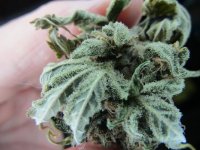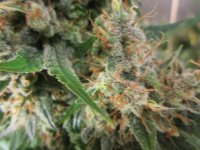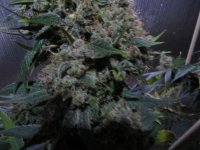I don't see how using more fertilizer or additives could add any more resin to these buds. The buds were so heavy before cutting the plants down they could not have held any more weight. I used 1\3 the amount the manufacture recommended with no additives. I don't want any more weight than what I can get just using base nutrients. The weed is Killer and I'm super pleased with the results of this low-feed high CEC grow method. Plus I save a lot of money using this method. 
-
ICMag with help from Phlizon, Landrace Warden and The Vault is running a NEW contest for Christmas! You can check it here. Prizes are: full spectrum led light, seeds & forum premium access. Come join in!
You are using an out of date browser. It may not display this or other websites correctly.
You should upgrade or use an alternative browser.
You should upgrade or use an alternative browser.
DIY and other hydroponic formulas.
- Thread starter CannaT
- Start date
Three Berries
Active member
There is a sweet spot right where the topsoil meets the clay undersoil. The CEC is highest in this area and if a plant can find it the growth is stem-busting amazing. Farmers have known this for a long time and finding one of the spots made all the difference in a successful farm and bumper crops.. The question I had was, "I wonder if I could artificially copy the same principles indoors using some method to boost the CEC in a container. There are so many variables, so many questions unanswered. I'm still lost and learning each time I grow a new cycle. I've used different boosting materials and found that using just plant old good organic soil will do the trick when inserted in the soil-less substrate. However, there are some clays that need exploring more and mixed at different ratios, and find the one that works the best mixed with the organic cores. I truly believe one can equal Deep Water Culture yields by matching the Cation Exchange Capacity using these methods. The soils I added peat to above was all clay soils.
Most interesting on the clay. My area is know for a high quality soil called a timber clay. Very dark from the wood of oaks, cherry and hickory trees. The seed and bark collect in the low areas. But it is know for some of the best farm land around here.
I grow in Happy Frog soils. Been growing for a few years and just this year got interested enough to start to control the pH and worry about the mineral nutes. Have been using rain water for the last two years. The well water is really high at 450ppm, local limestone is about 8% Mg. But now have potassium, calcium problems.
Started using Masterblend nutes this week. And mixed a batch with rain and well. Rain I added Ca, Mg and K, the well water I just added the Master blend and then brought the pH up to 6.9 with a bit of ammonia. Reading here that may not be best for the flowering nutes. I also use so 0-0-22 langbeinite at the start. Potassium seemed to be my biggest deficit with the last two grows. My run off pH today was 6.6, first good watering after a week in flower. They have been defoliated so it really slowed the water use down.
Big Oaks, Cherry and Hickory trees are good signs of high cation exchange. I would like to get my hands on some of that clay to work with and measure. The trees drop organic matter every year boosting the exchange between the two, Both the organic matter and clay super-charge the plant's ability to attract nutrition. Right where the two meet is where the highest (CEC) and where plants thrive. If you tried to grow in either one by its self its total failure but mix the two at the right ratio and BOOM super growth.
Happy Frog potting mix has a neutral pH and needs to be lowered and maintained with their line of fertilizers for the best results. The main ingredient in Happy Frog is composted forest humus which has a neutral pH. Their line of fertilizers drops the pH in a suitable range for nutrient uptake. Peat mixes on the other hand are acidic and need to be raised or buffered with fertilizers. Fox Farms fertilizers don't work with peat mixes because it drops the pH into the poisonous range. the two growing models are completely different. Masterblend should have the potential acidity or basicity value printed on the fertilizer label. Your problem with Potassium may be due to the mismatch in the potential acidity or basicity value in the fertilizer and soil match. Its best to match the fertilizer with the substrate that's best suited for it.
Happy Frog potting mix has a neutral pH and needs to be lowered and maintained with their line of fertilizers for the best results. The main ingredient in Happy Frog is composted forest humus which has a neutral pH. Their line of fertilizers drops the pH in a suitable range for nutrient uptake. Peat mixes on the other hand are acidic and need to be raised or buffered with fertilizers. Fox Farms fertilizers don't work with peat mixes because it drops the pH into the poisonous range. the two growing models are completely different. Masterblend should have the potential acidity or basicity value printed on the fertilizer label. Your problem with Potassium may be due to the mismatch in the potential acidity or basicity value in the fertilizer and soil match. Its best to match the fertilizer with the substrate that's best suited for it.
Three Berries
Active member
I should ad that the Fox Farm that has potassium problems is the Ocean Forest blend, not the Happy Frog. And I just started using the MasterBlend fert for it's trace elements. Was using Miracle Grow and it doesn't have what I needed so it was off to the individual mineral supplements to try and fix. There is another thread her called Help with this deficiencies, that describes exactly what happened.
Initially looked like nute burn with a burnt new leaf tip initially. Then progressed to yellowing of the margins but the veins stayed green. Continued on to burnt edges, yellow margins and green veins and the leaf canoed upwards. Runoff pH was in the 6.2-6.6 range. I was using rain water with the nutes.
Again interesting about the soil building layers under the tree. It's near impossible to get grass to grow well. Mostly due to the mini accumulation of the hard tree material that takes about three to fours years to completely decompose. The hickory shell hulls and acorn hats along with the small twigs are what do this along with the deep shade. The soil transitions to yellow sand, yellow clay, then blue clay at about 15 feet.
Initially looked like nute burn with a burnt new leaf tip initially. Then progressed to yellowing of the margins but the veins stayed green. Continued on to burnt edges, yellow margins and green veins and the leaf canoed upwards. Runoff pH was in the 6.2-6.6 range. I was using rain water with the nutes.
Again interesting about the soil building layers under the tree. It's near impossible to get grass to grow well. Mostly due to the mini accumulation of the hard tree material that takes about three to fours years to completely decompose. The hickory shell hulls and acorn hats along with the small twigs are what do this along with the deep shade. The soil transitions to yellow sand, yellow clay, then blue clay at about 15 feet.
Here's an update, I'm letting the last two females finish on rainwater only as you already know. I'm giving a limited amount of water because the colas are so dense. I allow the plant to just barely start to wilt before I water and then only water with a small amount. (75 to 80-day) flowers in the end. Live photos. 
Attachments
Here's something worth mentioning and that's the taste of the buds. Using an organic core in the middle and a low ppm hydro feed, in the end after harvest, the buds taste better than reg hydro. After I finished processing the first 4 plants and I really noticed the taste this time (super nice). So much better tasting and cleaner vape clouds and that's with no flush. These buds are turning nicely on these live plants. 
Attachments
Here’s a basic recap: 
- Starting with pure water, Use dixie cups and plant seed in a high EC organic mix. (check out propagation forum)
- When the plant hits 4 nodes, up-pot into 1 gallon pot of the same soil.
- After the females show a flower insert the 1 gallon pot into a 5 gallon soil-less mix. Examples Pro-mix, Sunshine, Procision Media by Aurora.
- Use 3 times the amount of pure fortified water to the manufacture fertilizer recommendations. Low feed every watering around the core.
It's important to remember when using this method, the nutrient sequence is more important than nutrient quantity. Don’t break the sequence and keep it consistent with every watering. If the EC gets too high, just allow dis-charge, and if it gets too low, hold on to it without discharge. I have been holding on to everything in the end without any run-off, just living on what's in the pot.
Attachments
NOTE One can’t make a plant take a specific nutrient or force-feed a plant because the plant has a special selection mechanism that attracts the elements by their atomic weight. Each element has an atomic weight and electric charge and the plant will build receptor sites suited for those needed elements. The plant will build as many sites as it wants for holding and transporting the right elements. If the nutrient selection is complete the plant will build as many receptor sites needed for nutrient absorption and transport. When a plant can select elements by choice instead of forcing, the receptor growth is orderly and consistent making for robust growth. .
Here’s the problem with heavy nutrient saturation, when the plant is forced with heavy nutrient exposure the plant will get the atomic weight confused with some of the receptors and start accepting anything that’s close to the same weight or electrical charge and fill the receptor site with something that doesn’t belong. Since the nutrient is replaced with something that doesn’t belong it shows up as a nutrient deficiency. When the plant has the wrong elements due to over-saturation the building of new receptor sites slows. The plant can still grow but not at the same rate as a plant that has a complete nutrient selection. Finding the lowest "spot-on" nutrient feeding is much more productive than finding the highest spot or highest EC.
I think what you are saying could be simplified to: Having a proper ratio between nutrients and enaugh of every one of them in the feed is more important than having lots of feed.
And I totally agree. And I seen it in my past and present grows as well. I would personally rather try to nail the ratios than go overboard on nutes.
Great information in this thread!
And I totally agree. And I seen it in my past and present grows as well. I would personally rather try to nail the ratios than go overboard on nutes.
Great information in this thread!
I cut the last watering so the plant will lose turgor, and cause the flowers and leaves to wilt. Since the colas are fat and dense, I need to allow the stems to drain their liquid so to speak to keep mold out of the center of the buds. The biggest colas have to be trimmed right away and taken off the stem or mold can appear. Today is 75 in flowering and time to chop chop. Last shots alive
Attachments
My posts are not intended to say that any plant strain is better than another. I have used bag seed, Sativa, Indica, and crosses and always get the same result as I did above. Kickass growth with heavy resin production. I am surprised with every seed I have ever used with this easy hydro method.
That’s my DIY hydroponic and formula and its soooo easy!!. Any questions give me a shout-out. CreeperPark
That’s my DIY hydroponic and formula and its soooo easy!!. Any questions give me a shout-out. CreeperPark
Three Berries
Active member
I'm messing around with making my own Ca/Mg/K concentrate using Calcium (1200 ppm) and Magnesium chloride (600ppm) and some saturated dissolved Langbeinite KSO4,2MgSO4 solution to raise the pH to around 6.7 or so.
Found this article on Magnesium interesting.
Magnesium: Part of a Balanced Cannabis Diet
https://www.cannabisbusinesstimes.co.. .cannabis-diet/
Magnesium uptake is also affected by the presence of other elements. In general, a nutrient balance is obtained by targeting a 4:2:1 ratio of potassium (K) to calcium (Ca) and Mg. This helps avoid antagonisms among these elements. For example, if one element is excessive in the nutrient solution, then that can limit the plant’s ability to uptake adequate levels of the other two nutrients. Antagonistic situations commonly are observed with crops such as tomatoes, in which high levels of Ca are provided to avoid blossom end rot, or with geraniums, in which high levels of dolomitic limestone or flowable lime are added to avoid a substrate pH drop. Elevated levels of Ca limit the uptake of Mg, and these plants often develop deficiency symptoms.

Found this article on Magnesium interesting.
Magnesium: Part of a Balanced Cannabis Diet
https://www.cannabisbusinesstimes.co.. .cannabis-diet/
Magnesium uptake is also affected by the presence of other elements. In general, a nutrient balance is obtained by targeting a 4:2:1 ratio of potassium (K) to calcium (Ca) and Mg. This helps avoid antagonisms among these elements. For example, if one element is excessive in the nutrient solution, then that can limit the plant’s ability to uptake adequate levels of the other two nutrients. Antagonistic situations commonly are observed with crops such as tomatoes, in which high levels of Ca are provided to avoid blossom end rot, or with geraniums, in which high levels of dolomitic limestone or flowable lime are added to avoid a substrate pH drop. Elevated levels of Ca limit the uptake of Mg, and these plants often develop deficiency symptoms.
The nutrient sequence is more important than nutrient quantity. Nutrient waste can be minimized using fewer nutrients with pure water, and with less fertilizer. 


























